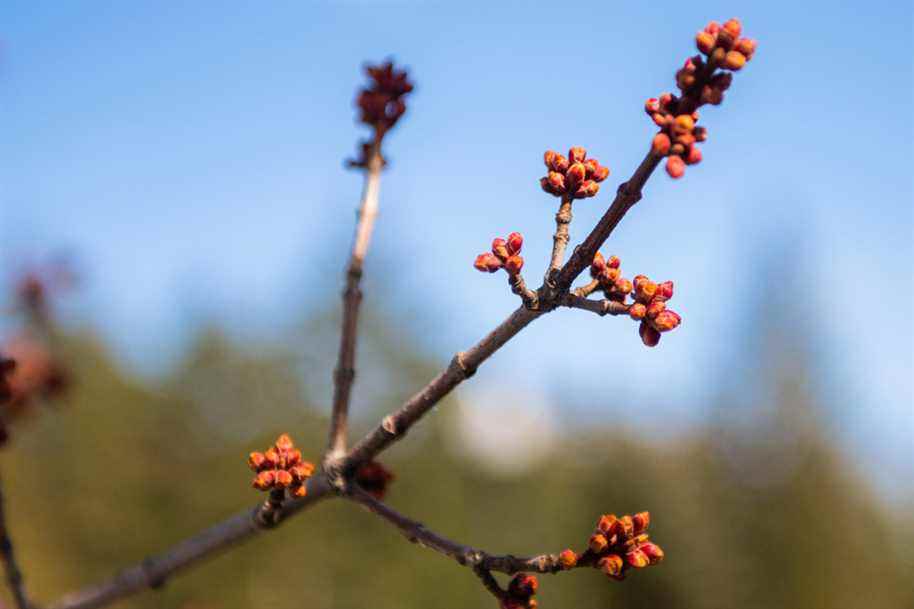From flowering trees to migrating butterflies, spring events are happening earlier and earlier due to global warming.
Posted at 8:00 a.m.
In 1947, Jean Combes began a titanic collection of data. The then 20-year-old amateur scientist began to annually record the date of the appearance of the first leaves in various trees in the south-east of the United Kingdom. Seventy-five years later, she hasn’t missed a year.
For Tim Sparks, professor of environmental science at the University of Cambridge, this data is a gold mine. “In the 1950s and 1960s, trees had their first leaves almost always in mid-April,” he reports. The dates have evolved gradually and are now three weeks earlier. »
Professor Sparks joined colleagues from European universities to assess whether this trend was widespread around the world. Their article recently published in the journal Nature Climate Change makes a clear observation: global warming is accelerating the arrival of leaves and flowers in the trees.

PHOTO CATHERINE LEFEBVRE, SPECIAL COLLABORATION
Tulips exposed to snow, at the Montreal Botanical Garden
The researchers analyzed the oldest series of annual tree data collected from countries in Europe and Asia. In all these series, leafing and flowering occurred on average earlier after 1985 than before 1950, with a difference varying from 6 to 30 days.
The Kyoto cherry trees are the centerpiece of the researchers. “This tree is associated with festivals in Japan, which allows us to have data dating back 1,200 years,” enthuses Tim Sparks. Last year saw the earliest flowering ever recorded.
In the animal kingdom
The early springs are also felt beyond the plant kingdom. “There’s a lot of evidence in animals,” says Tim Sparks. We see it in particular in the migrations of insects, amphibians and birds. »
Several species of birds are laying their eggs a month earlier than a century ago, according to a study at the University of Chicago.
Canada is no exception to the rule, observes Shawn Leroux. The Memorial University of Newfoundland biologist is closely monitoring the impacts of climate change on local species. “Virtually all the spring events that we observe arrive earlier in the country: the melting of the ice on the lakes, the arrival of butterflies, the budding of flowers, etc. he says.
species at risk
Is the early awakening of these ecosystems good news? Not necessarily, according to Tim Sparks. “I believe the biggest risk is the lack of synchrony between species,” he explains.
For example, as soon as spring arrives, the chickadees feed their chicks with caterpillars, which themselves feed on young leaves of trees that are still tender. However, global warming does not accelerate the development of these three interdependent species at the same rate.
Species find themselves without resources. They can move to find food if they are able to migrate and they can feed on other foods if they are able to adapt. If they fail to do either, they die.
Shawn Leroux, biologist from Memorial University of Newfoundland
Michel Labrecque, head of the scientific research and development division at the Montreal Botanical Garden, is more concerned about the upheavals in the weather caused by climate change.
The snowfall of April 19 bears witness to this. “What we are seeing most seriously at the moment are above all warming for a few days in March, followed by a return to much colder temperatures,” he notes.

PHOTO CATHERINE LEFEBVRE, SPECIAL COLLABORATION
Michel Labrecque, head of the scientific research and development division at the Montreal Botanical Garden
Plants that flower too early are at risk of frost. “It can destroy buds,” says the botanist. Some fruit trees cannot even produce. »
Of science and beliefs
Tim Sparks now hopes his research will raise awareness about the effects of global warming.
“People can’t visualize what an increase of tenths of a degree represents. On the other hand, if we say that spring will arrive weeks earlier, it becomes concrete, ”explains the professor of environmental sciences at the University of Cambridge.
Every year for 20 years, the professor has photographed the same landscapes in the United Kingdom. Its sample is not yet significant, but the images could be a gold mine for future generations of researchers.

